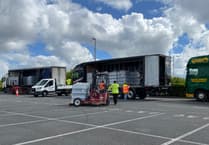FOR most Times readers driving from West Devon to the city of Plymouth on the busy A386, the trip is made more pleasurable by the five minute journey across Roborough Down. High up on the moors it offers an ever changing picture - the perfect place to enjoy nature’s four seasons and witness the ever changing mood of the landscape in sun, rain and its infamous Dartmoor ‘fog’.
However, as motorists speed by, many will not know, that just a few yards away from them - either side of the off the road are a plethora of ancient features of national significance - some dating back to the Bronze Age (1,000 BC), including hut circles and enclosures; there are also medieval longhouses, mine workings from Tudor times, to Drake’s Leat to provide water to Plymouth and, in more recent history, the creation of an important wartime airfield at RAF Harrowbeer — complete with a decoy airfield - and even a prisoner of war camp, near Bickham.
The significance of Roborough Common and Dartmoor is perhaps best reflected by records kept by the DNPA.
As Lee Bray explained: ‘So far we have 20,000 historical environment records of sites and features, 1,100 of which are deemed to be scheduled monuments of national importance. To give you an idea of Dartmoor’s importance, it contains 5% of English scheduled monuments in 0.7% of its area. That’s a lot of heritage crammed into a small area of Dartmoor!’
Lee, aged 50, is a man who loves his job with a passion. A qualified geologist, who worked on off-shore oil rigs in the North Sea, he later took a PhD in archaeology from Exeter University and went onto work at Exmoor National Park before joining Dartmoor National Park Authority just over two years ago.
‘What makes Dartmoor so special to me as an archeologist is that there is so much evidence of so many different times in history, sometimes one layer on top of another. For example we can find a medieval land boundary in the middle of a decoy airfield from the Second World War.
‘Everywhere you look is a treasure trove of archaeology and I consider it an absolute privilege to work here.’
We start at the iconic ’Rock’ at Yelverton, which throughout the year proves to be a magnet to visitors. a tor-like igneous rock outcrop immediately south-west of Yelverton. Just a hundred yards away are the remnants of the Second World War airfield RAF Harrowbeer. Still prominent are the massive dispersal bays, where groups of aircraft were sheltered by huge banks of earthworks which provided some protection from raiding enemy bombers and fighters and also stored ammunition within its earthworks.
Just five minutes drive down the A386 we park the cars and take a walk through the wild gorse and bracken at the west of the down.
Dartmoor always has been an important source of water, with the remains of both Drakes’ Leat from the 16th century and the 43 kilometre long Devonport Leat suppling the then town of Plymouth and its dockyards, which is still much in evidence,having been built in the 1780s.
Today we see the moors as wild and covered in gorse and bracken but it was not always so. The vast area was covered in forest before man began to cultivate it.
Lee added: ‘Dartmoor was central to the Devon economy. People would have brought their cattle and sheep to Roborough Down from all over the county. It was known as the ’Red Tide’, mainly for the Red Devons, as the cattle and people made their way in procession across the moors so their animals could graze the moors between summer and autumn and give their own lands a chance to regenerate.
‘Roborough Down’ was divided into fields in medieval times, with the monks of Buckland Abbey holding much of the land. There is still evidence of their boundary markers. Sometime, and we don’t know exactly when, but farmers were given the common right to graze their animals, which they still do today.’
But there are features on the landscape that go back to the Bronze Age.
Lee continued:?‘Prehistoric people loved to build their settlements in earthwork enclosures, it must have some sort of symbolic meaning to them as well as providing some security from wild animals and hostile neighbours. On Dartmoor we have many cairns (mounds of stone), which are ritual monuments going back to the Bronze Age (2,000BC), they can have different shapes; some are laid out in a doughnut-like rings, others are simple mounds. Some conceal the cremation burials in pots or pits and a few have included precious artefacts like bronze daggers or beads placed to accompany the dead into the afterlife.
‘The mystery of such features of Roborough Down is that we don’t always fully understand why they were built. But that’s what makes it all so fascinating and the further back we go the stranger it gets.’
Just a few yards off the A386 road on the Clearbrook side as the moor ends there — hidden to the undiscerning eye - among the gorse — Lee finds evidence of a simple farmstead, which could have dated back anytime from the Iron Age (800 BC) period.
Just across the road, a few hundred yards away, Lee outlines a site called Roborough Camp, amid the bracken, which consists of two earthwork ramparts and ditches, one inside the other.
‘It is another mystery; it could be a prehistoric settlement and we know it was used as a beacon in Tudor times as it is shown on a map of the time, but parts of it may be much later. The exact sequence and date of its construction remains to be discovered,’ said Lee.
‘The site itself has been scarred by miners digging for tin or copper, their workings having destroyed part of both ramparts, probably during post-medieval times. Copper mining is much in evidence at the other extreme of Roborough Downs, where the Virtuous Lady copper mine near Walkhampton is situated, which was named after Queen Elizabeth 1.
‘What I find intriguing about Roborough Down is not just the archaeological features themselves but how many people who use and enjoy the area are completely unaware of all the wonderful evidence right in front of them on the landscape.’ said Lee.
‘Also so fascinating about Roborough Downs is the variety of ways in which people have used and exploited it over thousands of years. This has included farming and digging valuable minerals from the ground as well as using it as a base for warplanes, or a place to keep prisoners of war.
‘Now, as its-age-old use for grazing animals continues, a new use as a place to enjoy the open-air, a site for picnicking or to walk dogs has come to the fore. I like to think that the remains left behind by others who have used the area in times past form an important part of that even though they may not be noticed by many’
‘I’m amazed by the sheer variety of so many historical features that can be found in such a relatively small area; evidence of mankind dating from the Bronze Age to the Second World War. It’s an archaelogist’s dream.’



